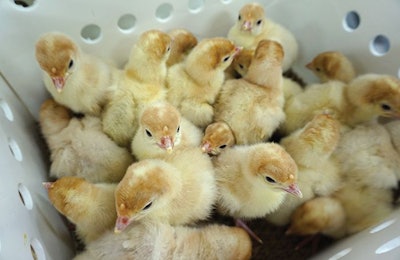
In the past decade, two of the world’s largest genetics companies moved into leading roles in supplying poults to turkey growers in the U.S.
Those companies: Aviagen, which calls itself the world’s leading poultry breeding company, and Hendrix Genetics, which calls itself the world’s leader in turkey and layer breeding, recently made major investments in turkey breeding and hatching infrastructure in the U.S. and Canada. In the past decade, the genetics companies injected more than $100 million into commercial turkey breeding and hatching.
For Aviagen, this includes more than $60 million spent on the construction of two new hatcheries – located in Osceloa, Iowa, and Terre Haute, Indiana – and further investment in new farms in Missouri and Canada. It also acquired farms in North Carolina, Michigan and Illinois. In 2018, Aviagen produced 170 million turkey hatching eggs. Hendrix spent more than $70 million on its operations, which include a new hatchery in Beresford, South Dakota, and new farms in Ipswich, South Dakota. The Beresford hatchery’s annual capacity is 35 million eggs.
In an interview with WATT PoultryUSA, the leaders of those company’s respective turkey operations said they entered the market due to the reduced number of multipliers and the lack of spending on new farming and hatching facilities.
The poult supply chain
The turkey industry in the U.S. and Canada is different from the broiler industry in terms of supplying hatchlings to farms. Integrated broiler companies often run their own breeder farms and hatcheries and supply them to their contract growers. The picture is not as clear in turkey farming.
Over its development from small- to large-scale farms, a patchwork supply network developed. This network consisted of: multipliers who produced poults to be sold to farmers, producers who traded poults with each other to balance their own supplies, and other agents who acted as middlemen in getting poults to farmers. Today, about half of the turkey companies handle poult production themselves. The other half relies on third-party suppliers.
A changing market
About 15 years ago, more than 10 companies were in the multiplication business, Aviagen Turkeys President Jihad Douglas said. Now, many are gone – some were acquired and others went out of business – because the margins are slim and the expenditure to stay in business is high. Aviagen acquired Nicholas in 1999. In 2008, Aviagen acquired B.U.T. and relaunched its combined operations as Aviagen Turkeys.

Jihad Douglas, Aviagen Turkeys (Courtesy Aviagen)
In 2011, Aviagen Turkeys decided it needed to expand and invest in the multiplication business. It believed it could apply its existing expertise and infrastructure toward commercial breeding and eliminate the middleman between itself and the customer. The company built a hatchery in Iowa and established Valley of the Moon Commercial Poults to produce poults for the industry.
In 2017, Aviagen formed a new unit to supply commerical poults, Select Genetics, through the merger of Valley of the Moon and Minnesota turkey multiplier Willmar Poultry/AgForte. At the time, Willmar was the largest multiplier in the country. Today, Aviagen’s turkey brands include Nicholas and B.U.T. Its Valley of the Moon brand focuses on niche and specialty turkey breeds.
Jeff McDowell, Hendrix general manager for the Americas, said it also noted the shifting ownership structure of turkey hatcheries and saw an economic opportunity to enter the business and apply its own expertise. When Select Genetics was formed, it changed the market dynamics and Hendrix saw a need to respond.

Jeff McDowell, Hendrix Genetics (Courtesy Hendrix Genetics)
State-of-the-art facilities
Both McDowell and Douglas said new hatcheries benefit from all of the technological progress that’s taken place since the last wave of turkey breeder farms and hatcheries were built 20 or 30 years ago. The new facilities benefit from advances like standardized single-stage incubation, improved biosecurity, advanced analytical software and labor saving devices.

New facilities benefit from advances in hatching technology like standardized single-stage incubation and advanced software. (Photo by Austin Alonzo)
Douglas said the customer wants high-quality, healthy poults and are demanding Salmonella control for food safety purposes. This drives Hendrix and Aviagen to pay for and maintain clean, state-of-the-art facilities run by qualified staff. McDowell said Hendrix is adding automated devices at points of transfer to improve worker ergonomics and reduce labor needs.
These improvements, nevertheless, have a cost for the consumer. Higher quality infrastructure and birds require a return on that investment, the suppliers say.
“When you make investments it creates a higher cost base to a point, but there is also benefits of higher quality and better poult starts,” McDowell said. “We continuously hear feedback of really good seven day starts … we hear it regularly that (customers) appreciate this investment to help make sure they stay competitive in the future.”
Competition ahead?
Although there are a number of other multipliers in the business still, the arrival of the multinational genetics companies to the market foreshadows competition between the two going forward. Both Aviagen and Hendrix declined to discuss market share and price information.
Douglas said the genetics companies are investing in the future by revitalizing a segment that needed new infrastructure and introducing improved genetics to the supply chain.
“(Hendrix) came to the game, which is great because all of us have to invest to make the turkey protein more competitive and we have to use state-of-the-art infrastructure,” Douglas said. “We always try to be ahead of our competition by coming up with ideas whether it is on the breeding side or whether it’s investment or infrastructure.”

















